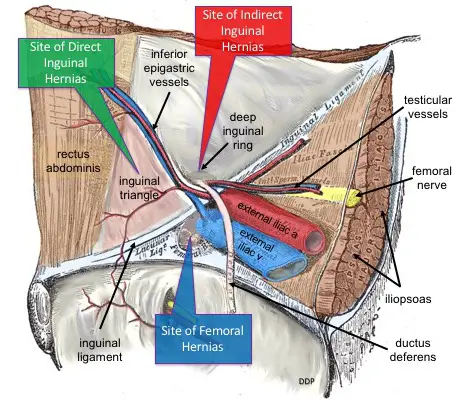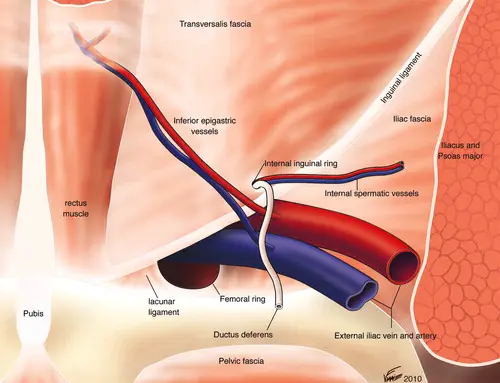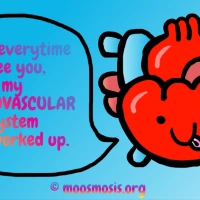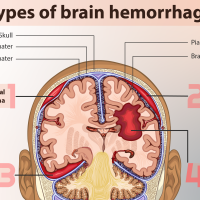Medical School Anatomy: Test your knowledge with our anatomy practice exams and practice tests with provided questions and answers. Free practice exam questions and answers on inguinal anatomy, inguinal hernias, and inguinal rings.
Medical School Anatomy: Practice Exam – Practice Test Questions & Answers
Medical School Anatomy: Abdomen and Pelvis Topics
1. Anatomy Questions: Inguinal Anatomy and Inguinal Hernias
To gain a comprehensive understanding of the inguinal anatomy, inguinal rings and inguinal hernias, please check out our easy-to-understand educational article on the anatomy of hernias: Direct vs Indirect Hernias –> Then test your knowledge with the questions and practice test below!
Part 1. The Anatomy of Superficial and Deep Inguinal Rings: Practice Test Questions & Answers
Q: Describe the surface anatomy of the superficial and deep inguinal rings.
A: Superficial – immediately superolateral to the public tubercle
Deep Inguinal Ring – 1 cm superior to the inguinal ligament and 1 cm medial to its midpoint
Q: What lies in the preperitoneal space immediately medial to the deep ring?
A: Inferior epigastric vessels
Q: Certain kinds of congenital inguinal hernias are more frequent in premature than full-term baby boys. Which kind and why?
A: Congenital = indirect inguinal hernia
Q: What is the most common type of hernia in women?
A: Indirect Hernia (Surprise, it wasn’t femoral hernia. Femoral hernias are more common in women than compared to men, but femoral hernias are not the most common type of hernia.)
Q: What is the one kind of groin hernia that is equally or more common in women than in men, and why?
A: Femoral because women have relatively wider pelvis resulting in a relatively larger femoral ring

Part 2. The Anatomy of Inguinal Rings and Hesselbach’s Triangle: Practice Test Questions & Answers
Q: Describe the surface anatomy of the deep and superficial inguinal rings.
A: Yes, we are asking this question again if you didn’t notice. Practice makes perfect!
superficial: immediately superolateral to the public tubercle; deep: 1 cm superior to the inguinal
ligament and 1 cm medial to its midpoint
Q: These rings are actually holes in other structures – name those structures
A: superficial: external oblique aponeurosis
deep: transversalis fascia
Q: What lies in the preperitoneal space immediately medial to the deep ring?
A: inferior epigastric vessels
Q: Which type of hernia passes through Hesselbach’s triangle?
A: direct hernia passes through the hesselbach’s triangle

Part 3. Anatomy of Inguinal Hernias and Clinical Applications: Practice Test
3.During surgery to repair an inguinal hernia, you put a surgical staple immediately medial to the deep inguinal ring.
What is the worst consequence you might anticipate?
A: Hemorrhage from the inferior epigastric artery
After the patient recovers from the surgery, he complains of numbness over the front of his scrotum and on the inside of his upper thigh. What might have happened?
Ilioinguinal nerve has been damaged.
Check out this popular article to learn more about Direct Hernia vs Indirect Hernia!

Check out our popular nervous system articles!
Check out these popular articles 🙂
Circulatory System: Blood Flow Pathway Through the Heart
Ectoderm vs Endoderm vs Mesoderm
Circulatory System: Heart Structures and Functions
Ductus Arteriosus Vs Ductus Venosus Vs Foramen Ovale: Fetal Heart Circulation
Cardiac Arrhythmias: Definition, Types, Symptoms, and Prevention
Upper Vs Lower Respiratory System: Upper vs Lower Respiratory Tract Infections
Seven General Functions of the Respiratory System
Digestive System Anatomy: Diagram, Organs, Structures, and Functions
Kidney Embryology & Development: Easy Lesson
Autocrine vs Paracrine vs Endocrine: What are the Differences?
Their Eyes Were Watching God: Mule Symbol
Shoulder Abduction Muscles: Medical Anatomy and USMLE
Cell Membrane Dynamics: Flippase vs Floppase vs Scramblase
Cell Membrane Fluidity: Factors That Influence and Increase the Cell Membrane Fluidity
Psychology 101: Crowd Psychology and The Theory of Gustave Le Bon
Introduction to Evolution: Charles Darwin and Alfred Russel Wallace
Copyright © 2022 Moosmosis Organization: All Rights Reserved
All rights reserved. This essay first published on moosmosis.org or any portion thereof may not be reproduced or used in any manner whatsoever
without the express written permission of the publisher at moosmosis.org.

Please Like and Subscribe to our Email List at moosmosis.org, Facebook, Twitter, Youtube to support our open-access youth education initiatives! 🙂















You never see the unimaginable amount of information a doctor has to learn, memorize and remember when you watch those doctor shows on TV. This little exercise helped me understand – and appreciate – how tedious it must be to learn fact after fact (after fact) about the human body. I can see why so many doctors specialize: I have the poorest memory of anyone I know (one of the biggest reasons that I write). I can’t imagine having to commit the entire human body to memory. Not much wonder so many doctors I have known don’t really ‘get’ the mental health side of a patient: that’s a whole other field of study to learn…😬
LikeLiked by 2 people
Thank you for your insightful comment, Patti! Yes, indeed, there is an incredible amount of information to be learned for young medical students and aspiring physicians! To put into perspective, two semesters of biochemistry, for example, in undergraduate college are condensed into only a few weeks for medical students, on top of learning medical anatomy and all sorts. Sending lots of gratitude to our medical students and doctors around the world. We also have immense respect for all writers around the world! So thank you, Patti, for sharing your amazing stories! Cheers to the bright future ahead of us!
LikeLiked by 1 person
🙂🙂🙂
LikeLiked by 1 person
Excellent article on hernias!
LikeLiked by 2 people
Thank you Tiffany! 🙂 So happy to help!
LikeLiked by 1 person
Superb essay on hernias and anatomy! Very helpful
LikeLiked by 2 people
Thank you Logan! That is very kind of you. We’re so glad to hear we helped!
LikeLiked by 1 person
Wow! This is phenomenal. Love your articles and site!
LikeLiked by 2 people
Thank you Jackie Ben Sharko! That’s very kind of you. Happy learning!
LikeLiked by 1 person
Perfect timing for my exam on inguinal hernias and surgery 😆
LikeLiked by 2 people
Awesome! So happy to hear this helped! 😀
LikeLike
This is superb!
LikeLiked by 1 person
Thank you K. Stevenson! Your kindness is always deeply appreciated!
LikeLike
What an amazing article on hernias! My gramps just had hernia surgery. This is really helpful for understanding it.
LikeLiked by 1 person
Best recoveries to your grandpa, Bill! So glad this article was helpful.
LikeLiked by 1 person
Love this article! Beautifully written and very helpful!
LikeLiked by 2 people
Excellent points! Very well organized and insightful explanations of hernias.
LikeLiked by 1 person
Wow!! This is very helpful, perfect for class!
LikeLiked by 1 person
Superb article on hernias! My dad just had hernia surgery
LikeLiked by 1 person
Thank you May!! That’s very kind of you 🙂 Well wishes for your dad, godspeed!
LikeLike